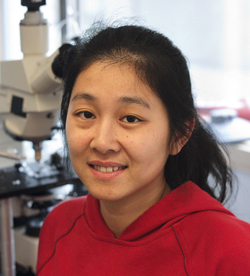Tianyi Mao, Ph.D.

Senior Scientist, Vollum Institute
Biography
After earning her B.S. in Biological Science and Biotechnology at Tsinghua University in Beijing, China in 1997, Mao received her Ph.D. in Neuroscience from the Johns Hopkins University School of Medicine in 2005. She did postdoctoral research at the Cold Spring Harbor Laboratory and then at the Howard Hughes Medical Institute's Janelia Farm Research Campus. Mao was appointed as an assistant scientist at the Vollum Institute in September 2010 and was promoted to Scientist in 2017 and to Senior Scientist in 2024.
Summary of current research
The basal ganglia are critical for many fundamental brain functions, such as movement control and decision-making. Dysfunction of the basal ganglia contributes to the pathophysiology of many neurodegenerative diseases, most notably Parkinson's disease and Huntington's disease. Our understanding of the basal ganglion has been limited by the complexity of the circuitry. For example, increasing evidence suggests that neurons in the basal ganglia are heterogeneous, yet little is known about the anatomical and functional connectivity of individual cell types.
In my laboratory, we examine the functional connectivity within basal ganglia and its interaction with cerebral cortex and thalamus. We target defined cell types by combining novel functional circuit analysis tools and molecular genetic technology with classical anatomical tracing. We also use two-photon imaging with genetically encoded calcium sensors to study the signal transduction events in basal ganglia that underlie the dynamics of functional circuitry.
Alterations in basal ganglia circuits also are associated with behavioral perturbations in drug addiction and neurodegenerative diseases. A mid-term goal of our research program is to investigate how the circuitry changes during different behaviors (e.g. goal-directed vs. habitual), and in animal models of addiction.
These projects are expected to be synergistic. With these complementary approaches, we aim to determine the cell-type specific circuitry, a prerequisite for a mechanistic understanding of basal ganglia function in health and disease.
Learn more about Dr. Mao's research in this Research Week 2017 interview
Selected publications
Ma L, Day-Cooney J, Benavides OJ, Muniak MA, Qin M, Ding JB, Mao T#, Zhong H#. (2022) Locomotion activates PKA through dopamine and adenosine in striatal neurons. *Co-first Authorships. #Co-senior Authorships. Nature. 611(7937):762-768.
Massengill CI*, Bayless-Edwards L*, Ceballos CC, Cebul ER, Cahill J, Bharadwaj A, Wilson E, Qin M, Whorton MR, Baconguis I, Ye B, Mao T, Zhong H. (2022) Sensitive genetically encoded sensors for population and subcellular imaging of cAMP in vivo. Nat Methods. 19(11):1461-1471.
Wilson EA, Mao T, Zhong H. (2022) Labeling Endogenous Proteins Using CRISPR-mediated Insertion of Exon (CRISPIE). Bio Protoc. 12(5):e4343.
Day-Cooney J, Dalangin R, Zhong H#, Mao T#. (2023) Genetically encoded fluorescent sensors for imaging neuronal dynamics in vivo. #Co-senior Authorships. J Neurochem. 164(3):284-308.
Melander JB*, Nayebi A*, Jongbloets BC, Fortin DA, Maozhen Q, Ganguli S#, Mao T#, Zhong H#. (2021) Distinct in vivo dynamics of excitatory synapses onto cortical pyramidal neurons and parvalbumin-positive interneurons. *Contributed equally. #Co-correspondence. Cell Reports.
Melander JB, Nayebi A, Jongbloets BC, Fortin DA, Qin M, Ganguli S*, Mao T*, Zhong H*. (2021) Distinct in vivo dynamics of excitatory synapses onto cortical pyramidal neurons and inhibitory interneurons. *Corresponding authors. Cell Reports, In press.
Massengill CI, Day-Cooney J, Mao T, Zhong H. (2021) Genetically encoded sensors towards imaging cAMP and PKA activity in vivo. J. Neurosci. Methods 362:109298.
Zhong H, Ceballos CC, Massengill CI, Muniak MA, Ma L, Qin M, Petrie SK, Mao T. (2021) High-fidelity, efficient, and reversible labeling of endogenous proteins using CRISPR-based designer exon insertion. eLife Jun 8; 10:e64911.
Jongbloets BC, Ma L, Mao T, Zhong H. (2019) Visualizing Protein Kinase A activity in head-fixed behaving mice using in vivo two-photon fluorescence lifetime imaging microscopy. J. Vis. Exp. Jun 7; (148) doi: 10.3791/59526.
Birdsong WT, Jongbloets BC, Engeln KA, Wang D, Scherrer G, Mao T. (2019) Synapse-specific opioid modulation of thalamo-cortico-striatal circuits. Elife 8:e45146.